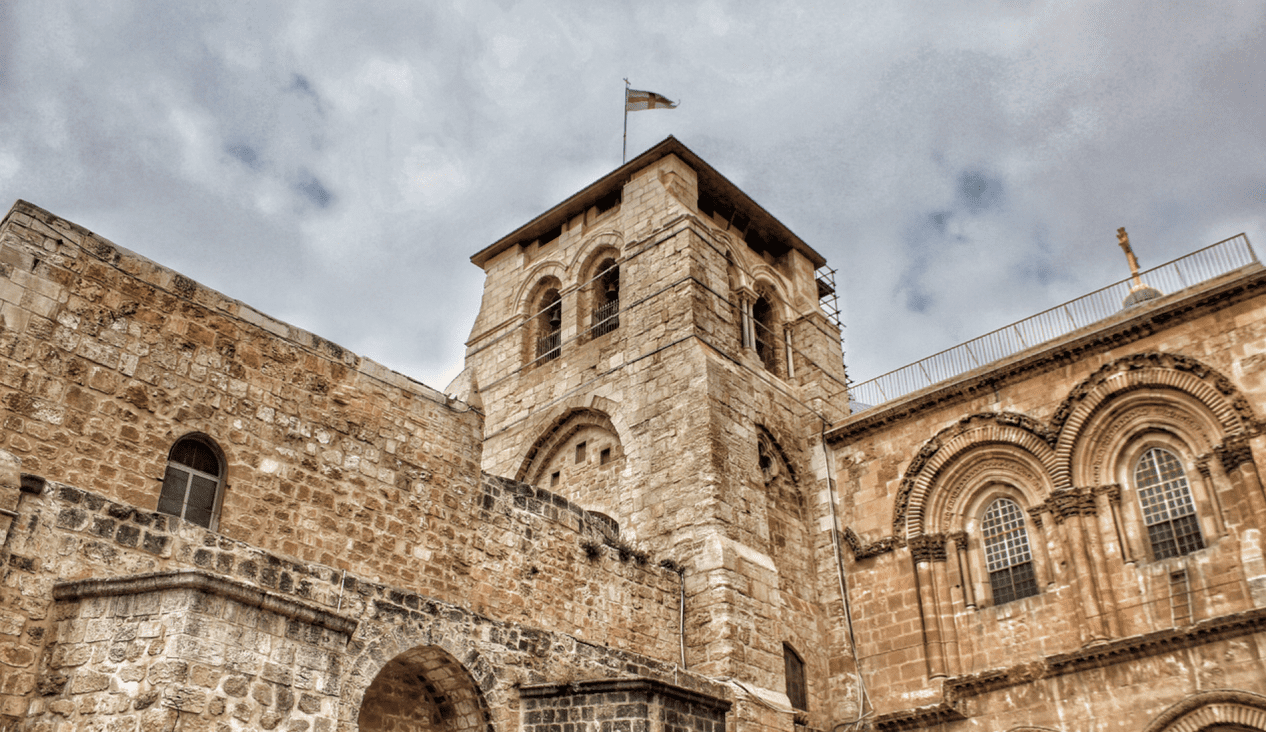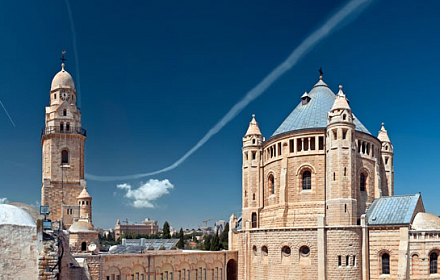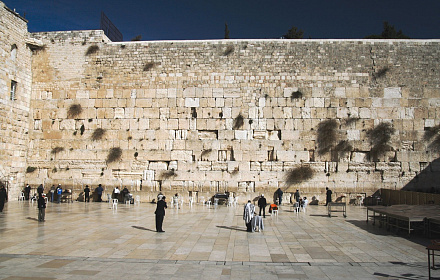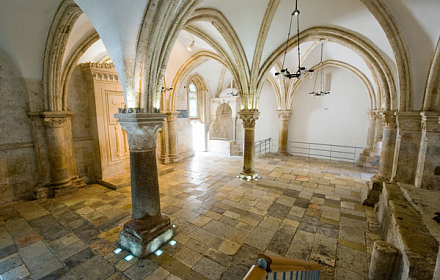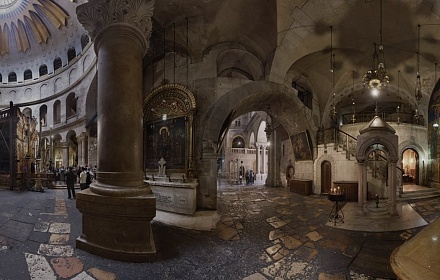About Virtual Tour
Entrance
The Cathedral of Saint James is located in the Old City’s Armenian Quarter and belongs to the Armenian Apostolic Church in the Holy Land. It was built in the 12th century at the Crusader-era on the site of an ancient Byzantine basilica and has become spiritual center of Jerusalem’s Armenian community. It is also a venerated holy site, known as the place where Apostle Saint James – the first bishop of Jerusalem – was beheaded. In fact, the cathedral is dedicated to two Apostles, both named James. The place is closely bound up with James son of Zebedee (brother of John the Apostle) and James the brother of Jesus – the first bishop of Jerusalem. Let's go on a virtual pilgrimage
James son of Zebedee, a fisherman of the Sea of Galilee, was one of the twelve disciples. He dedicated several years to preaching the doctrine of Christ throughout Europe. After his return to Jerusalem, he was seized upon the order of Herod Antipas and was put to death. The cathedral stands on the place of his execution; his honorable head is also buried here. The saint’s body was later transported to Spain, where a city was named after him — Santiago de Compostela. “Iago” in Spanish means “James”, but for Armenian Christians it’s “Akop”.
There was another James — James the Less, a relative of Jesus Christ according to the flesh and ordained by Him. This James is more commonly known as “brother of the Lord” (naturally by that we understand that they were possibly cousins). He presided the Council of Jerusalem —Assembly of the Apostles and is the author of epistles that were included into the New Testament. He became the first bishop of Jerusalem and converted many people to Christianity, which angered many Jews. According to historian Titus Flavius Josephus, around 62 AD bishop James was seized upon the order of the high priest Hanan ben Hanan and was stoned to death by an angry mob.
Having made out to which of Christian saints this Armenian cathedral is dedicated, we can take a walk through the tunnel into the courtyard, which looks as a well, to find the church entrance.
Churchyard1
The construction of St. James Cathedral began in the 12th century and continued until the 18th century. The view of the churchyard, which opens before the pilgrims’ eyes, is the result of multiple extensions, renovations and restorations that lasted for more than six centuries — although in some places, parts of the oldest structures have been preserved. An 18th-century wooden door adorned with overdoor ornamentation is a real eye-catcher. It’s also the burial place of Gureg Israelian — the 94th patriarch of Jerusalem and Abraham — the contemporary of Saladin.Armenians are known as very good builders and construction workers; this talent has saved them many times throughout the history of this nation. For example, in 1948 during the Israeli War of Independence the Armenian Quarter of Jerusalem was badly damaged, but thousands of people saved their lives by hiding behind meter-thick walls of the cathedral during mortar shellings.
Believers who are members of cathedral’s congregation can recall many miraculous healings that took place here. The unique atmosphere of the church is felt as soon as you enter into its courtyard. This is an incredible place with a special “prayed-in” feeling, where one can stay for hours — the more so there is much to see.
Churchyard
Time is a tireless architect. Age after age the appearance of the main Armenian church in the Old City of Jerusalem has been progressively changing. According to 17-th century pilgrim Symeon Lehaci, at his time he had a chance to see not only the cathedral, but also St. Thoros church and the church of the Holy Archangels, many monastic structures, bakeries, two spacious stables and other types of facilities.Interestingly, the worshippers are summoned to worship services not by a church bell, but by a wooden semantron. This is a tribute to the time period that lasted until the end of 19th century when Muslim authorities did not allow Christians ring their bells. This is why monasteries used the semantron instead to summon their congregation, producing a strong resonance when wood struck wood.
Khachkars — Armenian cross-stones adorned with additional motifs were donated and placed in cathedral’s courtyard.
A churchman can be seen at the cathedral’s entrance. His duty is to ensure that persons going into the church appeared as piously as possible: women dressed in overly-revealing outfits as well as men wearing shorts will not be allowed inside. (While planning to go on a tour into the Old City, it would be recommended to dress as for a visit to church).
There is another common rule to observe inside the Cathedral of Saint James. As a rule, the benches in front of the entrance are filled with tourists. If any of them crosses his legs, a local clergyman would certainly make him a critical remark, requesting never to do that again. Such position — crossed legs — is seen here as a demonstration of disrespect for divine service and worshippers.
Cathedral
Before you enter the church, something needs to be said about the history and present times of Jerusalem’s Armenian community. The first Armenians settled in the Holy Land as early as in the 1st century AD. Since the official adoption of Christianity in Armenia (it was the first ancient world country to adopt it as a state religion — in 301 AD) in the 4th century, the number of Armenians in Jerusalem began to grow — mostly because of pilgrims and monks, who took permanent residence, but also thanks to merchants and people of other occupations and professions. They are mostly concentrated on Mount Zion near the Cenacle. In the Byzantine era the Armenian Church was proclaimed heretical: its property was confiscated and hierarchy was expelled. After the Islamic conquest of 637, the Armenian Church tried to regain the lost positions and recognized the authority of the caliph Umar ibn Al-Khattab, and agreed to pay the head money upon the return of Armenians to the Holy City.After the Crusaders took over in the Holy Land, the Armenian community of Jerusalem became even more numerous — Christian kings took local Armenian women to be their wives. That’s when the Armenian Quarter was born — it is still there today. The Cathedral of Saint James was among the buildings that were founded at the time.
Both the Israeli War of Independence and the Six-Day War of 1967 caused enormous damage to the Armenian Quarter. Thousands of families left: while before 1948 about 16 thousand Armenians lived in this area, since 1967 their numbers fell to slightly more than a thousand. Today there are some five thousand persons living in the Armenian Quarter — mostly artists and artisans. Despite its relatively small size and number of inhabitants, the Armenian community of Jerusalem is very active and coherent: in this Quarter there are national schools and shops. Two local libraries that both possess unique collections are famous far beyond Jerusalem. One of them is the library of Patriarchate, where many ancient manuscripts are kept. Another is Calouste Gulbenkian library — founded by a philanthropist of Armenian origin renowned for his contributions to the local Armenian community in the first third of the twentieth century.
Cathedral1
As most basilicas that were built at the time of Jerusalem Kingdom, the Cathedral of Saint James was constructed in Romanesque style and oriented towards the east. The main part of the building has a round shape, surmounted by a conical dome. On all sides it’s linked to tall narrow towers.We move away the leather cover and go inside the cathedral. Many oil vigil lights and lit candles hang from the ceiling, illuminating the inner space of the church. Both interior and the front of the building are decorated with icons, frescos and hammer-works. The cathedral walls are adorned with unique ceramic tiles handmade by ancient craftsmen — they depict the quotes from the Holy Scriptures in Ancient Armenian language.
The high altar is dedicated to the Saint James — the younger of the two. The right altar – to John the Baptist and the left one is the Lady altar.
Interestingly, the Armenian patriarch of Jerusalem has continuity with the first bishop of Jerusalem — Apostle St. James brother of the Lord. The large throne on the right side of the choir, intricately carved and topped by a baldachin, is dedicated to him. The smaller and more modest one is the seat of the current Armenian patriarch of Jerusalem. It is believed that the Holy Apostle is present in spirit on the day when a solemn mass is held in his honor.
Hallway
If you enter the cathedral through the above-mentioned 18th-century carved door, on the left side of the entrance you will see three small chapels. One of them contains the relics of Saint Macarius of Jerusalem who was an Armenian bishop of Jerusalem in the 4th century, during the rule of Constantine the Great.Another chapel is dedicated to Saint Menas (sometimes spelled as Minas). Inside of it there are altars of Menas and Sarkis the Warrior – a saint in the Armenian tradition.
The third chapel stands upon the site of death and subsequently site of burial of Apostle James. According to tradition, the Jews threw the first bishop of Jerusalem from the top of the church and while still alive he was stoned to death.
In the south wing of the cathedral stands Echmiadzin Church, which was an open narthex until the mid-seventeenth century. In 1663 the patriarch Egiazar Aintapzi established here a throne and transformed the narthex into the church. The central place in the paintings of Echmiadzin is given to the scene of baptism of king Tiridates III of Armenia by Saint Gregory the Illuminator.
In the first third of the 18th century another altar appeared near the southern wall of the church — in honor of Holy Sinai. Three stones from mount Sinai were brought here. It was done because the access to holy sites on the Sinai Peninsula remains difficult— but at the same time they are particularly venerated by pilgrims. Later, some stones from mount Tabor, Jordan Valley and the Church of the Holy Sepulcher were added.
In addition, inside the cathedral there are chapels in honor of the Holy Sign, Holy Apostles and Ascension.
A mere listing up of the relics and historical artifacts held inside the Cathedral of Saint James would take much time.
Besides the things that we have already mentioned, especially noteworthy are the 18th century porcelain tiles brought from Turkey, featuring depictions of Jesus Christ life scenes. There is a great number of other historical artifacts that date back to antiquity or more recent times. In short, when visiting the Armenian Quarter of the Old Jerusalem, it is well worth spending at least a couple of hours inside this magnificent cathedral.
Send donation
If you are in a difficult financial situation, we will light the candle for free. For that purpose email us at coordinator@santosepulcro.co.il
Payment Methods
